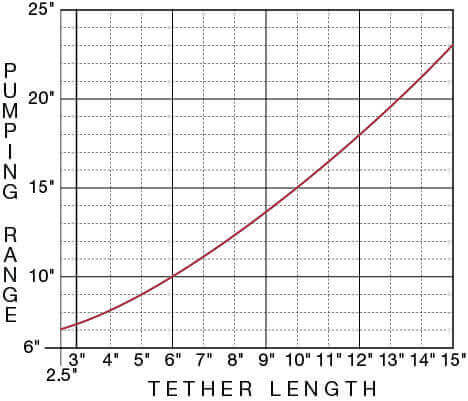| Black Common Red Normally Open (Pump Down) White Normally Closed (Pump Up) |
| Pole 1 Black and White Pole 2 Green and Red |
| Pole 1 | Brown Normally Open (Pump Down) Green Common Blue Normally Close (Pump Up) |
|
| Pole 2 | Red Normally Open (Pump Down) Black Common White Normally Close (Pump Up) |
- Attach cord, using a cable tie, to any convenient rigid surface as illustrated. This is known as the tether point. Do not tighten until both turn-on and turn-off levels are established.
(See Fig. 1) - To adjust greater distance between turn-on and turn-off, increase cord length between tether point and float. For less distance between turn-on and turn-off decrease cord
(See Chart Fig. 2) - Make sure the float is at least 2 inches above pump base, in the turn-off position, before tightening cable tie at the tether point.
- Plug piggy-back switch cord (Currant Tap) into grounded outlet, then plug into piggy-back switch cord, and check for proper operation.


- Attach cord, using a cable tie, to any convenient rigid surface as illustrated. This is known as the tether point. Do not tighten until both turn-on and turn-off levels are established.
(See Fig. 3) - To adjust for greater distance between turn-on and turn-off; Increase cord length between tether point and float. For less distance between turn-on and turn-off, decrease cord length.
(See Chart Fig. 4) - Make sure levels are correct, and that the float moves freely with no obstructions, then tighten cable ties.


Deciding whether your float switch needs to be normally open or normally closed for pump control can be a little confusing. So we would like to clear things up.
When we say normally open or normally closed, we are referring to an electrical circuit. An open circuit is incomplete, meaning that the electric current is unable to complete the loop due to a gap. A closed circuit is complete with no gaps, enabling the current to travel through the whole loop.
With level switches, these circuits are opened and closed by the float either moving up or down based on the rising or falling level of the liquid. Deciding whether or not you want the circuit to be closed or opened when the float is either up or down can be tricky.
The most effective way to decide is to determine what the switch should do when the float is at rest. When we say at rest, we mean that the float is not suspended in the liquid. We often see confusion with the term normal as others have misinterpreted it as a float suspended. Remember, normal, in terms of switches, refers to a float at rest.
So, if you want the switch to be energized, or on, when the float is at rest, then you will need the switch to be normally closed. If you want the switch to be de-energized, or off, when the float is at rest, then you will need the switch to be normally open.
Also, it may be helpful to know that normally open switches are typically used for pumps that empty a tank, while normally closed switches are typically used for pumps that fill a tank.
Let us know if you need help deciding whether you need normally open or normally closed switches and we will be glad to help.
| 12-2 | 7 1/2" |
| 14-3 | 5" |
| 14-2 | 4" |
| 16-3 | 4" |
| 18-2, 18-3, 16-2 | 3 1/2" |
| Wire Gauge | Minimum Length |
| Based on SJOW cord @ 65° F. Flexibility of wire varies Test in actual application to verify |
|